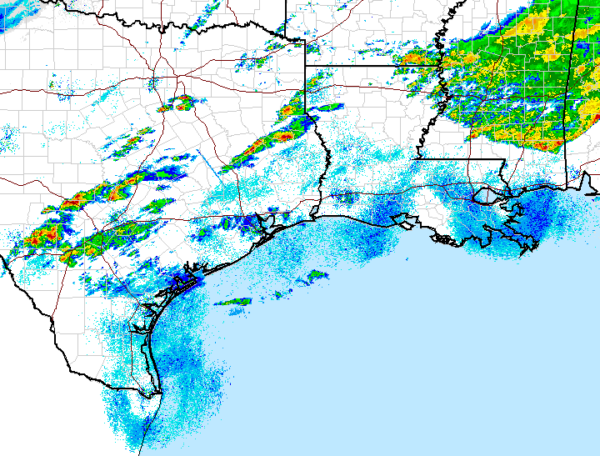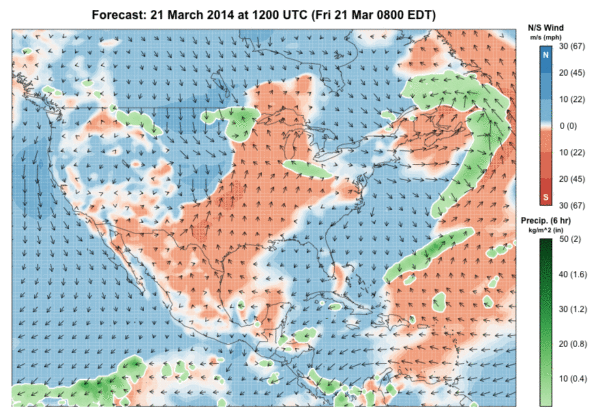Continental Summary Light to moderate movements in the West were most evident in the Desert Southwest and California, while strong low pressure passing through the East brought unseasonably cold and unfavorable conditions and kept most moderate movements sparse in space and time. Species on the move this week included White-faced Ibis, Chimney and Vaux’s Swifts, […] Read more...
This week’s species on the move discussion highlights some advanced arrivals gleaned from this past weekend’s eBird reports. Northern Parula is being reported with greater frequency than the 10-year average for this date in the Great Plains and Upper Midwest and Northeast. This is particularly true in the Great Plains, where a huge spike in […] Read more...
As forecast last week, a frontal boundary is approaching the Texas and Louisiana coasts this morning. The map below shows the current conditions in Texas and along the Gulf Coast. Note that barbs and wind flags represent the direction from which winds are blowing, and the blue line with triangles is the boundary between warm and […] Read more...
Continental Summary Scattered light to moderate movements that begin the weekend give way to much more widespread movements to end the period in the West, while moderate to heavy movements will occur in many areas of the East as low pressure organizes and moves off the coast (and begets more Gulf Coast fall outs). Species […] Read more...
Continental Summary A nice pulse of moderate movements early to midweek in the West contrasted a pattern of late week moderate to locally heavy movements in the East. Species on the move this week included Hooded Merganser, Horned and Red-necked Grebes, Turkey Vulture, Broad-winged and Swainson’s Hawks, Ring-billed and California Gulls, Chimney Swift, Blue-gray Gnatcatcher, […] Read more...
Species on the move this week features birds that are catching up on their schedules, exploding on to the scene, and falling out. Eastern Phoebes finally began to arrive in large numbers in the Northeast, effectively erasing delays in arrivals experienced during previous weeks. Orchard Orioles are now appearing on checklists with frequencies more like […] Read more...
Continental Summary Scattered light to moderate movements expand across the region by early week in the West, fallouts spread east from the Texas coast from the weekend through early week as a cold front stalls in the Gulf of Mexico, and the East sees a big pulse of migrants to end the forecast period. Species […] Read more...
Continental Summary A mostly quiet West experienced scattered light to moderate movements, primarily in California and the Desert Southwest, while several disturbances in the East scattered light to moderate movements across the few favorable periods of the week. Species on the move this week included Osprey, Swainson’s Hawk, Franklin’s Gull, Great Crested Flycatcher, Eastern and […] Read more...
BirdCast is updating the previous migration alert for the Gulf Coast. This update is as of 5pm EDT 3 April 2014. Conditions are favorable for a moderate exodus of birds from Mexico and portions of northern Central America later tonight (Thursday 3 April). Note that conditions are not favorable for South American departures (will this mean […] Read more...
Here’s a brief review of some species that showed substantial changes in reporting on eBird this past weekend. Hooded Orioles have been on the move in the last week, appearing in slightly more reports than the last decade’s average. Bullock’s Oriole, however, seems to be right on track with the last ten years of reports. […] Read more...
Continental Summary Several widespread light to moderate flights color this forecast period in the West, while a pulse of favorable conditions that produces weekend flights in the Plains and early week flights in the East eventually gives way to a strong cold front that spawns fallouts and shuts down the whole system to end the […] Read more...
Continental Summary The West experienced scattered light to moderate movements as mostly unfavorable conditions for larger and more widespread flights did not materialize; the East saw pulses of light to moderate migration bracketing the forecast period. Species on the move this week included Blue-winged and Green-winged Teal, Greater Scaup, Hooded Merganser, Double-crested Cormorant, Great Blue […] Read more...
2014 may be a year to remember for linking bird movements to patterns of sea surface temperature (SST) anomalies. Many along the Atlantic and Gulf Coasts will certainly remember the winter of 2012-2013 for, among other reasons, the crazy Razorbill invasion in the southeastern US and Florida, and even into the Gulf of Mexico and its […] Read more...
Here’s a brief recap of of some species that showed substantial changes in reporting on eBird this past weekend. From the Great Lakes and Northeast region, several species took advantage of favorable conditions, especially in the early part of the weekend. Tree Swallows, Eastern Phoebe, Blue-winged Teal, and Osprey all made moves during this time. Interesting, […] Read more...
Continental Summary Light to moderate movements were widely scattered across the southern portions of the West this week, while scattered light to moderate movements highlighted an otherwise uneventful week of migration pulses in the East. Species on the move this week included Blue-winged and Green-winged Teal, Northern Pintail, Ring-necked Duck, Great Egret, Turkey Vulture, Broad-winged and […] Read more...
Continental Summary A widespread movement in the West on Tuesday night will be followed by a similarly large-scale movement in the East on Thursday night. Species on the move this week will include Blue-winged Teal, Northern Pintail, Common Goldeneye, Common Loon, Double-crested Cormorant, Turkey Vulture, Swainson’s and Broad-winged Hawks, Ring-billed Gull, Scissor-tailed Flycatcher, Tree, Northern Rough-winged, Cliff, and Barn […] Read more...
Once again, we’ll highlight some species that took advantage of the weekend to move. First, let’s check in with Red-necked Grebe again. Recall that at this time last week, this species was on the increase in the Upper Midwest and Northeast. We interpreted this peak as “numerous displaced and confused winter birds still finding many areas […] Read more...
Continental Summary Widely scattered light to locally moderate movements occurred in the West, while the East experienced widespread light to moderate and locally heavy movements early in the week. Species on the move this week included Canada Goose, Gadwall, Ring-necked Duck, Hooded Merganser, Double-crested Cormorant, Sandhill Crane, Killdeer, American Woodcock, Eastern Phoebe, Black-and-white and Lucy’s […] Read more...
Continental Summary Marginal conditions that begin the period in the West become more favorable for increasingly widespread light to moderate movements over the course of the forecast period, while the East experiences several bouts of favorable winds and warming temperatures the kickstart movements to begin the weekend and the week. Species on the move this […] Read more...
In our first weekly forecast for spring 2014, BirdCast highlighted the potential for fallouts and concentration of migrants in the Florida peninsula: “By midweek conditions favorable for migrant arrivals and departures are limited to Florida North to the Carolinas; and birders in these areas should watch carefully for fallouts of early migrants where precipitation and […] Read more...























